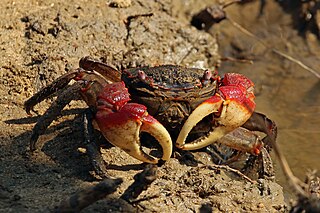
Bavayia is a genus of lizards in the family Diplodactylidae. Species in the genus Bavayia are also known commonly as New Caledonian geckos or bavayias. The genus is native to the remote New Caledonia and Loyalty Islands. The 41 species are moderately small to medium-sized geckos, and are distinguished from other genera by their tail length and the shape of their digits.

The Rhizophoraceae is a family of tropical or subtropical flowering plants. It includes around 147 species distributed in 15 genera. Under the family, there are three tribes, Rhizophoreae, Gynotrocheae, and Macarisieae. Even though Rhizophoraceae is known for its mangrove members, only the genera under Rhizophoreae grow in the mangrove habitats and the remaining members live in inland forests.

Rhizophora mangle, the red mangrove, is distributed in estuarine ecosystems throughout the tropics. Its viviparous "seeds", in actuality called propagules, become fully mature plants before dropping off the parent tree. These are dispersed by water until eventually embedding in the shallows.

Rhizophora is a genus of tropical mangrove trees, sometimes collectively called true mangroves. The most notable species is the red mangrove but some other species and a few natural hybrids are known. Rhizophora species generally live in intertidal zones which are inundated daily by the ocean. They exhibit a number of adaptations to this environment, including pneutomatophores that elevate the plants above the water and allow them to respire oxygen even while their lower roots are submerged and a cytological molecular "pump" mechanism that allows them to remove excess salts from their cells. The generic name is derived from the Greek words ριζα (rhiza), meaning "root," and φορος (phoros), meaning "bearing," referring to the stilt-roots.

Salim Ali Bird Sanctuary is an estuarine mangrove habitat, which is declared as the bird sanctuary, and located on western tip of the Island of Chorão along the Mandovi River, Goa, in India. The sanctuary is named after Salim Ali, the eminent Indian ornithologist.

Rhizophora apiculata belongs to the Plantae kingdom under the Rhizophoraceae family. Currently R. apiculata is distributed throughout Australia, Guam, India, Indonesia, Malaysia, Micronesia, New Caledonia, Papua New Guinea, the Philippines, Singapore, the Solomon Islands, Sri Lanka, Taiwan, the Maldives, Thailand, Vanuatu, and Vietnam. Rhizophora apiculata is called ‘bakhaw lalaki,’ in the Philippines, "Thakafathi ތަކަފަތި" in the Maldives, 'Đước' in Vietnam, Garjan in India, as well as other vernacular names.

The Southern Africa mangroves are mangrove ecoregion on the Mozambique's southernmost coast and the eastern coast of South Africa.

Rhizophora mucronata is a species of mangrove found on coasts and river banks in East Africa and the Indo-Pacific region.

Rhizophora stylosa, the spotted mangrove, red mangrove, small stilted mangrove or stilt-root mangrove, is a tree in the family Rhizophoraceae. The specific epithet stylosa is from the Latin meaning "stylus form", referring to the flower.

Anthony Hume Whitaker was a New Zealand herpetologist, contributing a 50-year career of fieldwork, pioneering research and species discoveries. His is still the largest collection of reptile and amphibian specimens donated to Museum of New Zealand Te Papa Tongarewa.

Rhizophora racemosa is a species of mangrove tree in the family Rhizophoraceae. It has a patchy distribution on the Pacific coast of Central and South America, occurs in places on the Atlantic coast of that continent, and has a more widespread range on the Atlantic coast of West Africa.

Bavayia crassicollis, also known as the strand bavayia is a gecko endemic to the Loyalty Islands in New Caledonia.

Bavayia cyclura, also known as Günther's New Caledonian gecko or the forest bavayia is a gecko endemic to Grande Terre and Ile des Pins including their neighboring islets in New Caledonia.
Bavayia geitaina, also known as the gracile bavayia, is a species of geckos endemic to southern Grande Terre in New Caledonia.

Bavayia robusta, also known as the robust forest bavayia, is a species of geckos endemic to Grande Terre and Île des Pins in New Caledonia.

Bavayia septuiclavis, also known as Sadlier's New Caledonian gecko or the pale-stripe bavayia, is a gecko endemic to southern Grande Terre in New Caledonia.

The Trinidad mangroves ecoregion covers the separate mangrove forest areas on the coast of the island of Trinidad, in the country of Trinidad and Tobago. The character of the mangroves is affected by the large amount of fresh water flowing out of the Orinoco River and Amazon River to the south, which flow northwest around the island. The mangroves of Trinidad are found on all coasts, and are usually in the estuaries of rivers, but also found in coastal lagoons.
Bavayia campestris is a species of geckos endemic to New Caledonia.
Bavayia insularis is a species of geckos endemic to New Caledonia.
Bavayia occidentalis is a species of geckos endemic to New Caledonia.














